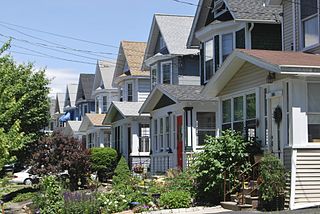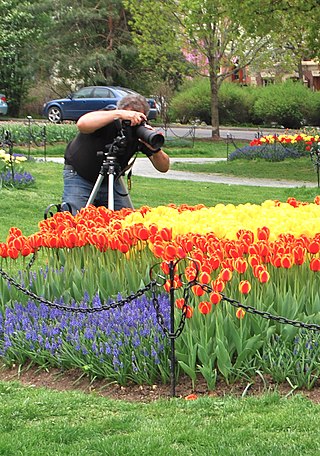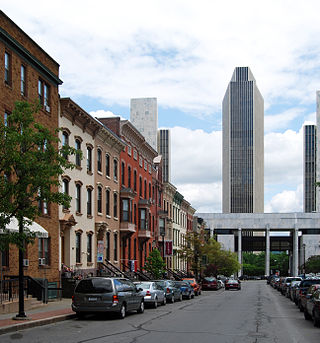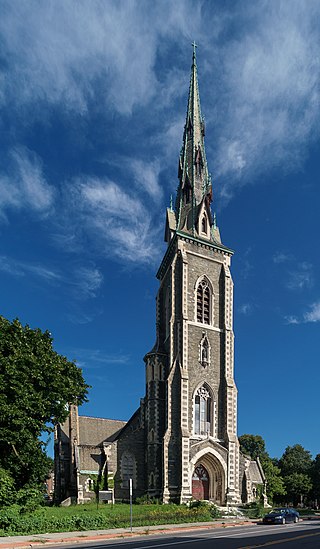
Albany is the capital and oldest city in the U.S. state of New York and the seat of and the most populous city in the county of the same name. It is located on the west bank of the Hudson River, about 10 miles (16 km) south of its confluence with the Mohawk River, 135 miles (220 km) north of New York City, 170 miles (270 km) west of Boston, and about 220 miles (350 km) south of Montreal.

Washington Park in Albany, New York is the city's premier park and the site of many festivals and gatherings. As public property it dates back to the city charter in 1686, and has seen many uses including that of gunpowder storage, square/parade grounds, and cemetery. The park is often mistaken as being designed by Frederick Law Olmsted, as it incorporate many of the philosophical ideals used by Olmsted when he designed Central Park in Manhattan. The park is about 81 acres (33 ha) in size with the 5.2-acre (2.1 ha) Washington Park Lake, a roughly 1,600-foot-long (490 m) and 140-foot-wide (43 m) lake, in the southwestern corner.

Schenectady City Hall is the seat of government of the city of Schenectady, New York, United States. Designed by McKim, Mead, and White, the building was constructed between 1931 and 1933. It is located on the block between Clinton, Franklin, Jay and Liberty streets. It is built in a revival of the Federal Style, the dominant style of American architecture from 1780 to 1830. Its most prominent features include the square clock tower, with its gold-leaf dome and weathervane, and the Ionic neoclassical portico. It houses not only city government but the local office of U.S. Rep. Paul Tonko.

The W. Averell Harriman State Office Building Campus is an office park in western Albany, New York, United States that houses sixteen New York State Government office buildings. The land totals roughly 330 acres (130 ha) and over 3 million square feet of office space, and about 7,000 state employees work there. The campus was built during the 1950s and 1960s in a suburban, car-oriented style bordered by an outer ring road that cuts the campus off from the surrounding neighborhoods. The campus is flanked by Washington Avenue to the north, Western Avenue to the south, University at Albany to the west, and New York State Route 85 to the east. With its own steam generation power plant for cooling and heating the campus is mostly self-sufficient.

Wellington Row is a row of buildings along the south side of State Street in Albany, New York. It spans from 132 to 140 State Street and includes the Wellington Hotel, its namesake, the former Elks Lodge No. 49, former Berkshire Hotel, and a couple of row houses south of the Wellington Hotel. The Wellington Hotel included a second building called the Wellington Annex on Howard Street with an attached garage that both faced towards the back of Wellington Row. The row was placed on the Preservation League of New York State's Seven to Save list for the year 2000. The entire row is part of the Downtown Albany Historic District.

The Albany Convention Center (ACC) was a proposed convention center to be located in downtown Albany, New York. The complex was initially proposed by Albany Mayor Gerald Jennings in 1994. In 2004, the Albany Convention Center Authority (ACCA) was established by the New York Legislature as a New York State public-benefit corporation to develop plans for the ACC. Supported by Governor George Pataki, the project was awarded a $75 million grant in 2006. The anticipated price tag of the project was approximately $220 million, and a site between Broadway, Hudson Avenue, and the South Mall Arterial was selected. In 2008, 2009, and 2010, the ACCA acquired much of the property that made up the proposed site.

Downtown Schenectady is the central business district for the city of Schenectady, New York. It originated in the 1820s with the moving of the commercial and industrial interests east from the original 17th and 18th century settlement, spurred on by the development of the Erie Canal. Home to the headquarters and major manufacturing plants of two large corporations, General Electric and American Locomotive Company, Downtown Schenectady catered to tens of thousands of workers in its heyday. Typical of the post-industrial Northeastern United States and Upstate New York in particular, Downtown Schenectady saw a decline in manufacturing and population starting in the 1970s. Recent construction and renovation has caused the downtown area to become an entertainment mecca for New York's Capital District anchored by Proctor's Theatre.

The architecture of Albany, New York, embraces a variety of architectural styles ranging from the early 18th century to the present. The city's roots date from the early 17th century and few buildings survive from that era or from the 18th and early 19th century. The completion of the Erie Canal in 1825 triggered a building boom, which continued until the Great Depression and the suburbanization of the area afterward. This accounts for much of the construction in the city's urban core along the Hudson River. Since then most construction has been largely residential, as the city spread out to its current boundaries, although there have been some large government building complexes in the modernist style, such as Empire State Plaza, which includes the Erastus Corning Tower, the tallest building in New York outside of New York City.

North Albany is a neighborhood in the city of Albany, New York. North Albany was settled in the mid-17th century by the Patroon of Rensselaerswyck and his tenants and later became a hamlet in the town of Watervliet. Due to the Erie Canal being constructed in 1825, North Albany saw immense growth, with the Albany Lumber District and an influx of Irish immigrants lending the area the name of Limerick. Home to many historic warehouses and row houses, North Albany continues to be an important industrial neighborhood. Recent efforts have begun to gentrify the neighborhood by adapting heavy industry/warehouse use to artistic and entertainment venues, such as a German beer garden, an amusement park, live music venues, and arts and crafts marketplaces.
Pine Hills is a neighborhood in Albany, New York, generally defined as the area from Manning Boulevard to the west, Woodlawn Avenue to the south, Lake Avenue to the east, and Washington Avenue to the north. The neighborhood consists mainly of freestanding multi-unit, duplex, and semi-detached houses and is home to Albany High School, the LaSalle school, the College of St. Rose, and the Alumni Quad of the University at Albany. Though mostly residential due to historical reasons from its founding, Pine Hills is home to two neighborhood commercial districts ; Middle Madison, from Partridge to Quail streets was designated first, and then a latter designated district, Upper Madison, from Main Avenue to North Allen Street. The area of Pine Hills east of Main Avenue and north of Myrtle Avenue is commonly referred to as the student ghetto due to its predominant population of college-age students. The area of Pine Hills west of Main Avenue features many large Queen Anne, Folk Victorian, and Colonial Revival homes. Upper Madison, where it meets Western Avenue near St. Rose is the center of a commercial area, complete with a movie theater, grocery store, fast food strip mall, retail, restaurants, a library, community playhouse, police station, pharmacy, and elementary school.

Sheridan Hollow is a neighborhood in Albany, New York located in a ravine north of Downtown Albany. Capitol Hill to the south and Arbor Hill to the north flank the ravine. Often the neighborhood is overlooked by city residents, and outsiders who work in the neighborhood often don't recognize the name of the neighborhood. This is due to the identity of the Hollow being subsumed into its larger neighbor Arbor Hill, for instance news stories of events are often accredited to the wrong neighborhood. Being on undesirable land for development in colonial times, growth was slow in the Hollow and the neighborhood was populated through the centuries by a series of ethnic groups new to Albany, such as the Irish, Polish, and African Americans.

Major General George Henry Thomas, also known as the Thomas Circle Monument, is an equestrian sculpture in Washington, D.C. that honors Civil War general George Henry Thomas. The monument is located in the center of Thomas Circle, on the border of the downtown and Logan Circle neighborhoods. It was sculpted by John Quincy Adams Ward, best known for his work on the statue of George Washington in Wall Street, Manhattan. Attendees at the dedication in 1879 included President Rutherford B. Hayes, Generals Irvin McDowell, Philip Sheridan, and William Tecumseh Sherman, senators and thousands of soldiers.

Lincoln Park is an urban park in Albany, New York, with a unique history, from being the site of a skirmish in 1626 between the Dutch and Mohawks to brickyards and breweries to being Albany's first public playground. The park features Albany's only outdoor non-wading swimming pool, along with several tennis courts, basketball courts, and football and baseball fields. Within the park is the James Hall Office, a National Historic Landmark, and the Thomas O'Brien Academy of Science and Technology (TOAST) an elementary school.
The Tivoli Nature Preserve, also Tivoli Park, in Albany is the largest urban nature preserve in the Capital District.

Tricentennial Park is an urban park in Albany, New York built to commemorate that city's three hundredth anniversary as an incorporated city and is the site of several statues and monuments. The park encompasses the entire block bounded by Broadway to the east, Columbia Street to the north, James Street to the west, and Steuben Street to the south. First proposed in 1914 it was built in 1986 as part of the tricentennial celebrations of Albany's incorporation as a city in association with the renovation of the Albany Union Station.

Dana Park is a small .2-acre (810 m2) urban park in Albany, New York and includes a memorial to James Dana which doubles as Albany's last remaining horse trough. It is located in the Y-intersection caused by Delaware Avenue to the east and Lark Street to the west, with the third leg of the triangle formed by Dana Avenue. Madison Avenue forms a five-point intersection with Lark Street and Delaware Avenue at the eastern end of the park. The park is important to several different neighborhoods, Hudson-Park, Park South, and Lark Street.

Bleecker Park is a small .37-acre (0.15 ha) urban park in Albany, New York. The park is triangle-shaped, bounded by Madison Place to the south, Madison Avenue to the north, and Eagle Street to the west. The Cathedral of Immaculate Conception is across Eagle Street from the park, while Madison Place, which is only one block-long, consists of rowhouses primarily in High Gothic and Italianate architecture, built in the mid-to-late-19th century. Across from the park on Madison Street is the Empire State Plaza East Parking Garage, built in 1999/2000. The park features the oldest fountain in the city which is surrounded by a small circular garden, two circular beds are also in the park and each feature a shrub surrounded flowers, these small gardens make Bleecker Park "a most charming and restrained Victorian public garden" according to an article in the Albany Times Union.

St. Joseph's Church is a historic neo-gothic church edifice in the Ten Broeck Triangle section of Albany, New York's Arbor Hill neighborhood. The structure is considered a city landmark and an important part of the Albany skyline. The church closed in 1994. The City of Albany placed the church for sale in February 2023.

















